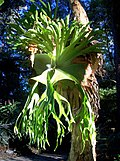| Image | Name | Distribution |
|---|
 | Platycerium alcicorne Desv . | Madagascar, Comoros Island, Mauritius, Réunion, Seychelles, Kenya, Mozambique, Tanzania, Zimbabwe. |
 | Platycerium andinum Baker | Colombia, Bolivia and Peru. |
 | Platycerium bifurcatum (Cav.) C. Chr . | Australia states of New South Wales, Queensland, Norfolk Island and Lord Howe Island. |
 | Platycerium coronarium (J. Koenig ex O. F. Müll.) Desv . | Indonesia Sumatra, Kalimantan, West Java, Malaysia, Singapore, the Philippines, Thailand, Cambodia, Myanmar and Vietnam. |
| Platycerium ellisii Baker | Madagascar only in the provinces of Antsiranana and Toamasina. |
 | Platycerium elephantotis Schweinf. | Angola, Benin, Burundi, Cameroon, Congo, Dem. Republic of Congo, Ethiopia, Gabon, Ghana, Guinea, Ivory Coast, Kenya, Liberia, Malawi, Mozambique, Nigeria, Rwanda, Senegal, Sierra Leone, Sudan and South Sudan, Tanzania, Togo, Uganda, Zambia, Zimbabwe, tropical Africa |
 | Large antler fern ( Platycerium grande (Fée) Kunze) | Philippines Province of Mindanao and Indonesia, in the Province of North Sulawesi and Gorontalo. |
 | Platycerium hillii T. Moore (Also referred to as a variety of Platycerium bifurcatum var. Hillii (T. Moore) Domin) | Australia Queensland, Papua New Guinea and Papua Indonesia. |
 | Platycerium holttumii de Jonch. & Hennipman | Malaysia, Northern Peninsular, State of Perlis, Kedah, Perak and Kelantan, Thailand and Indochina. |
 | Platycerium madagascariense Baker | Madagascar in the provinces of Antsiranana, Fianarantsoa and Toamasina. |
| Platycerium quadridichotomum (Bonap.) Tardieu | Madagascar only in Ankarana, Bemaraha, Bemarivo, Montagne d'Ambre including Fôret d'Ambre. |
 | Platycerium ridleyi Christ | Malaysia, Southern Thailand, Indonesia Sumatra and Kalimantan. |
 | Triangle antler fern ( Platycerium stemaria (P. Beauv.) Desv.) | Angola, Benin, Cameroon, Central African Republic, Congo, Dem. Republic of Congo, Equatorial Guinea (incl. Bioko), Gabon, Guinea Bissau, Liberia, Senegal, Sudan and South Sudan, Uganda, Principe, Sao Tomé, tropical Africa. |
 | Magnificent antler fern ( Platycerium superbum de Jonch. & Hennipman) | Queensland and New South Wales. |
 | Platycerium veitchii (Underw.) C. Chr. (Syn .: Platycerium bifurcatum subsp. Veitchii (Underw.) Hennipman & M. C. Roos) | Queensland. |
 | Platycerium wallichii Hook . | Northeastern India, Thailand, Laos, Malaysia, Myanmar and western Yunnan. |
 | Platycerium wandae Racib . | Papua New Guinea, Indonesia Papua and Maluku Island. |
 | Platycerium willinckii T. Moore (Also referred to as a subspecies of Platycerium bifurcatum subsp. Willinckii (T. Moore) Hennipman & M. C. Roos ). | Sulawesi and Java |
|




















